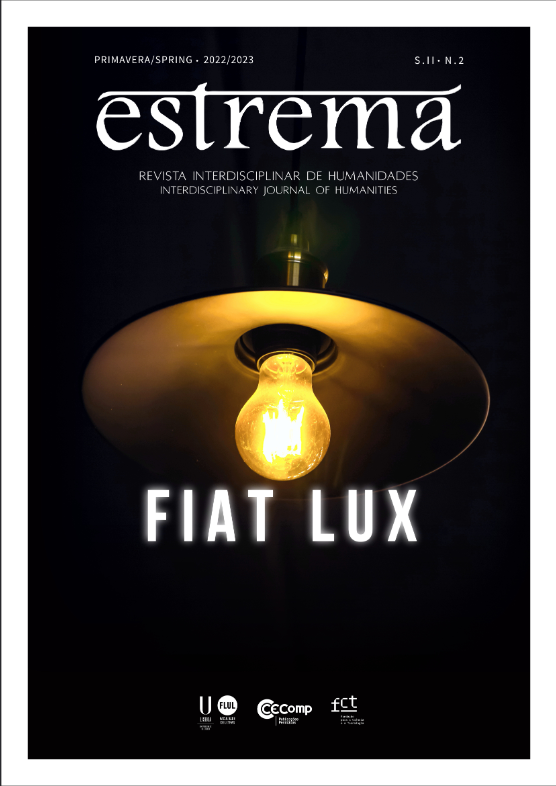A pedregosa luz da poesia ou a estética da ruína em Carlos de Oliveira
DOI:
https://doi.org/10.51427/com.est.2023.02.02.0002Keywords:
ruin; fragment; landscape; fire; Carlos de OliveiraAbstract
Carlos de Oliveira made the landscape of his childhood, the Portuguese Gândara, his literary universe, writing it, describing, and repopulating it incessantly in his work. Faced with a landscape in constant ruin, memory, and symbol of a country, one perceives, from the release of Cantata (1960), a radical mirroring of this landscape in his work. Starting from Michel Collot’s ideas about the landscape and its interaction with the lyrical subject and the concepts of aesthetics of ruin in Sophie Lacroix, I intend to analyze two poems by the portuguese poet — “Soneto” from Cantata (1960) and “Casa” from Sobre o Lado Esquerdo (1968). I will try to emphasize, mainly, the dialectic function of fire and light as builders and destroyers of realities, in addition to the close approximation of these elements with the language carried out by the author. In a process of “subject spacing”, Oliveira understands the end of the world that occurs every day in Gândara and in its houses as a primordial language to understand reality in its multiple possibilities, mainly in the absence, and promotes an “aesthetics of the fragment” in his literature, proposing formal fractures and diluting contours between subject, landscape, and poetry.
References
Bachelard, Gaston. 1989. A chama de uma vela. Tradução de Glória de Carvalho Lins. Rio de Janeiro: Bertrand Brasil.
Bachelard, Gaston. 1994. A psicanálise do fogo. Tradução de Paulo Neves. São Paulo: Martins Fontes.
Coelho, Eduardo Prado. 1972. A palavra sobre a palavra. Porto: Portucalense Editora.
Collot, Michel. 2013. Poética e filosofia da paisagem. Tradução de Ida Alves. Rio de Janeiro: Editora Oficina Raquel.
Cruz, Gastão. 2008. A vida da poesia: textos críticos reunidos. Lisboa: Assírio & Alvim.
Cruz, Gastã. 2017. “Carlos de Oliveira e o ofício de poeta.” Colóquio/Letras (195): 9-33.
Gandolfi, Leonardo. 2011. “Carlos de Oliveira e o ofício de contar nas dunas grãos de areia.” In Poetas que interessam mais: leituras da poesia portuguesa pós-Pessoa, organizado por Ida Alves e Luis Maffei, 27-44. Rio de Janeiro: Beco do Azougue.
Gusmão, Manuel. 2010. “A arte da poesia em Carlos de Oliveira.” In Tatuagem e palimpsesto: da poesia em alguns poetas e poemas, 315-338. Lisboa: Assírio & Alvim.
Lacroix, Sophie. 2020. Ce que nous disent les ruines: La function critique des ruines. Paris: Harmattan.
Martelo, Rosa Maria. 1996. “A construção do mundo na poesia de Carlos de Oliveira.”Tese de Doutorado, Universidade do Porto.
Martelo, Rosa Maria. 2000. “Casas destruídas: A revisitação de Casa na Duna em Finisterra de Carlos de Oliveira.” Revista de Faculdade de Letras Línguas e Literaturas (17): 251-260.
Marx, Karl. 2012. Crítica do Programa de Gotha. Tradução de Rubens Enderle. São Paulo: Boitempo.
Marx, Karl, e Friedrich Engels. 2010. Manifesto Comunista. Tradução de Álvaro Pina e Ivana Jinkings. São Paulo: Boitempo.
Oliveira, Carlos de. 1992. Obras de Carlos de Oliveira. Lisboa: Caminho.
Silvestre, Osvaldo Manuel. 2017. “A poesia póstuma de Carlos de Oliveira.” Colóquio/Letras (195): 9-33.
Simmel, Georg. 2019. “A Ruína.” Tradução António Sousa Ribeiro. In Simmel: a ruína, organizado por Carlos Fortuna, 55-65. Coimbra: Imprensa da Universidade de Coimbra.
Downloads
Published
Issue
Section
License
Copyright (c) 2023 Thalles Candal

This work is licensed under a Creative Commons Attribution 4.0 International License.
estrema provides open access to all its issues. Authors retain their copyright and grant the journal the right of first publication of their texts, as stipulated by the Creative Commons Attribution 4.0 International (CC BY 4.0) license. This license allows third parties to share the work, provided proper attribution is given to the author and the original publication in this journal is referenced.






